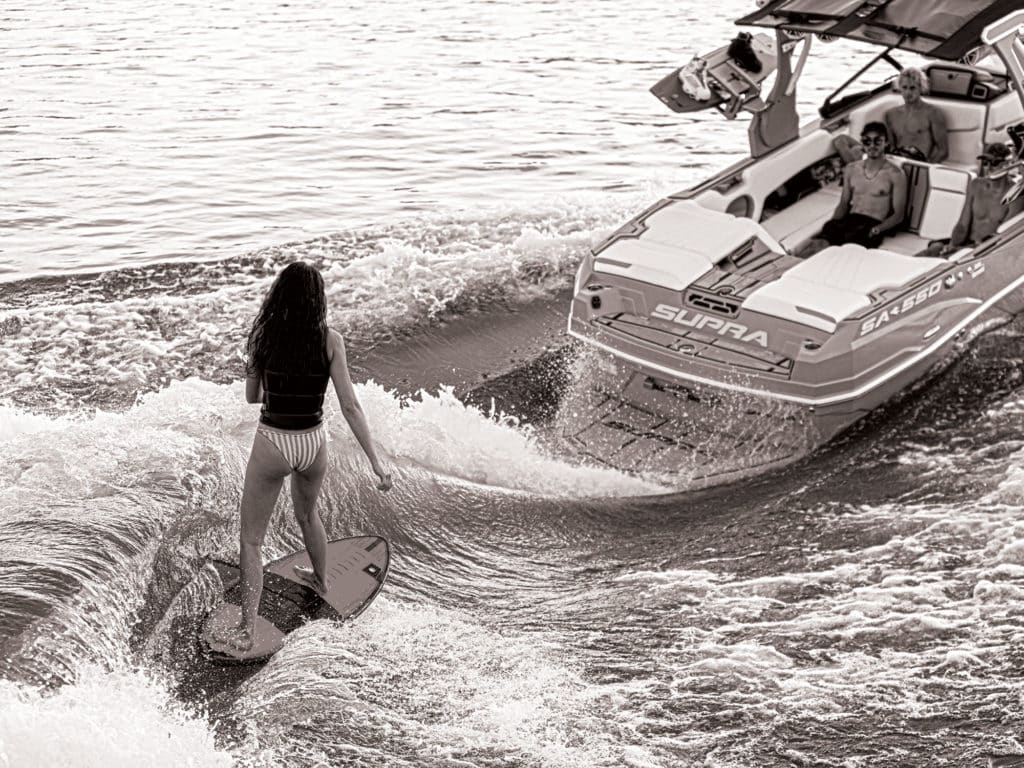
Watersports boats, aka tow boats, have grown in popularity over the years—and the numbers show it. According to statistics from the National Marine Manufacturers Association, since 2007, tow boats have enjoyed double-digit sales increases year over year. Much of this is due to the rise in popularity of wakesurfing and, more recently, wake foiling. The charge of that growth has been led predominantly by inboard boat manufacturers. However, with the introduction of Volvo Penta’s Forward Drive in 2015, many other manufacturers have been working for a piece of the watersports pie. Add in the fact that jet-drive manufacturers make boats with ballast systems, wakesurf wave-shaping devices and the like, and you can see that watersports popularity has spread to several other facets of the boating industry as a whole.
The result is there are more tow-boat brands, models and styles to choose from than ever before. But despite the influx of alternative brands and propulsion types, one fact remains the same: V-drive tow boats continue to produce the better-performing wakeboard wakes and wakesurfing waves. That’s mainly because inboard tow-boat manufacturers have spent decades with wake and wave performance as the leading elements of boat design. None of the alternative types of tow boats come close, nor do they have the same end goal. With that in mind, here are the main characteristics of inboards that help set them apart.
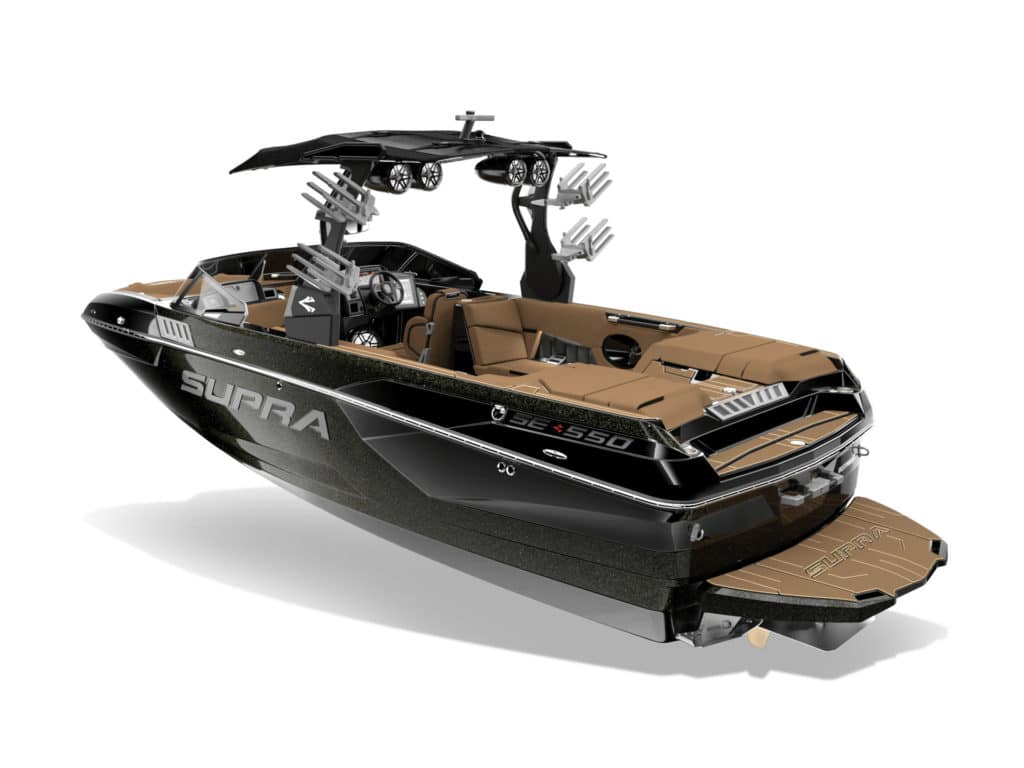
Hull Shape
Generally speaking, the hull shapes of inboard tow boats have been designed, tweaked and modified for the purpose of producing high-performance wakes and waves. This has to do with their mission. Many other builders, including those making forward-drive wakesurf boats, focus on overall performance efficiencies with hull design, such as top speed, fuel burn, etc.
We spoke with Zac Davis, engineering manager at longtime inboard tow-boat manufacturer Skiers Choice, and Kyle Norris, the engineer lead for fiberglass at Supra Boats, to get more perspective on inboard tow-boat hull design. From the get-go, it was clear that wake and wave performance is a calling card.
“Our primary focus with the design of our boats is creating a larger, cleaner wake and wave,” Norris says. “We aren’t necessarily as focused on high-speed efficiencies—that carries a lighter weight in our design criteria.”
“And a lot of that design can be attributed to time,” Davis adds. “Supra’s been designing and tweaking hulls for the purpose of towed watersports for 40 years. We dedicate a lot of manpower, time and money into optimizing the running surface—combined with the onboard systems—to make the best waves possible.”
Given the niche nature of the towed-watersports market and the number of brands that dominate it, it would be surprising to see an alternative propulsion brand put as much time and resources into optimizing running surfaces for peak wave performance. It’s likely not justifiable for the business model—nor needed for the boat buyers they pursue.
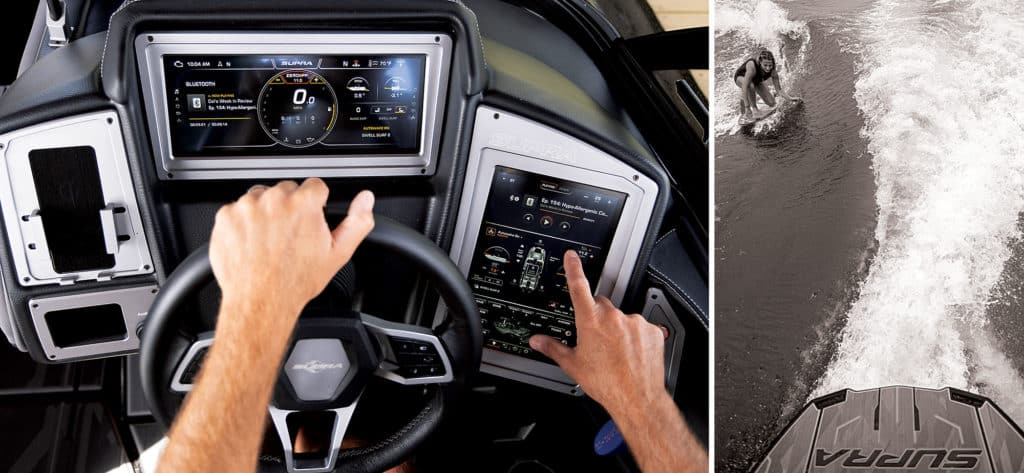
Onboard Systems
Other than the growing size—especially in the freeboard height—of inboard tow boats over the last 15 years, what’s changed the most is the advancement of onboard systems designed to enhance wakeboarding and wakesurfing performance. Wakesurfing on an older inboard used to mean filling large sacks with water to displace the hull more, then having everybody on board sit in one corner so a rider could surf whatever wave was produced around 11 mph. These days, internal ballast systems are large and efficient. Supra’s largest boat, the 24-foot-5-inch SE, features 4,100 pounds of subfloor ballast that can fill or drain in a matter of minutes. Combined with a boat that has a 6,150-pound dry weight and a passenger capacity of 18, you’re looking at serious displacement—only enhancing the ability to generate solid wakes and waves.
The development of wake-shaping systems is another major advancement. Oftentimes, these are the hydraulic-powered plates mounted to the port and starboard sides of the boat. Each brand’s system is a little different, but all are designed to produce similar results: customizable, clean waves for wakesurfing. Supra’s Swell 3.0 Surf System utilizes three plates: the port and starboard plates for wave formation, and a center-mounted plate—dubbed the Supra SmartPlate—for wave control and customization.
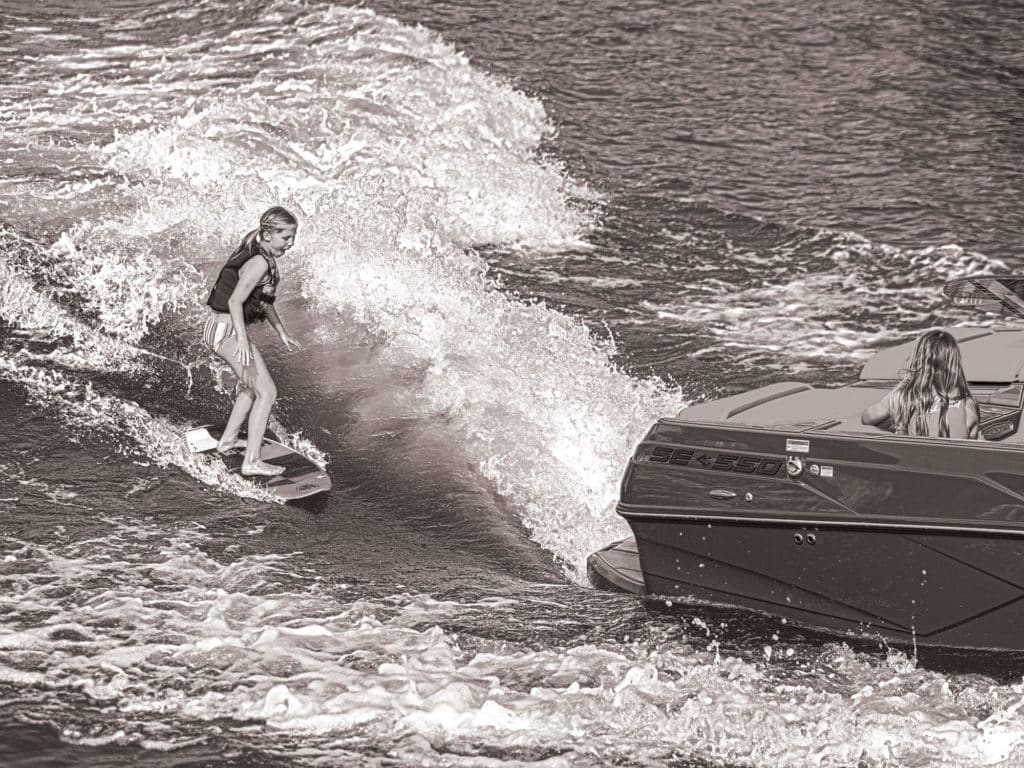
“All three plates are essentially extensions of the hull’s running surface,” Davis notes about Supra’s proprietary Swell 3.0 Surf System. “The system has been extensively updated and tweaked over the years to continue to perform more efficiently with our boats’ designs.” This harkens back to the idea of wave performance being a leading tenant in inboard boat design in today’s market. It’s one thing to add some ballast and some surf plates to an existing hull design, but it’s entirely different to design them specifically for optimal wake and wave shaping.
“Our goal,” Davis adds, “isn’t necessarily just about hull design. It’s about taking all of our systems and designing them to work as efficiently as possible to put the hull into the optimal running position.”
Supra achieves that mission through automation. The patented AutoWake system utilizes onboard sensors that measure the boat’s pitch, roll and running dynamics. Based on settings for an individual rider, AutoWake will automatically adjust ballast or the Swell 3.0 Surf System to keep the boat in the optimal position—ensuring consistent wakes and waves for any rider.
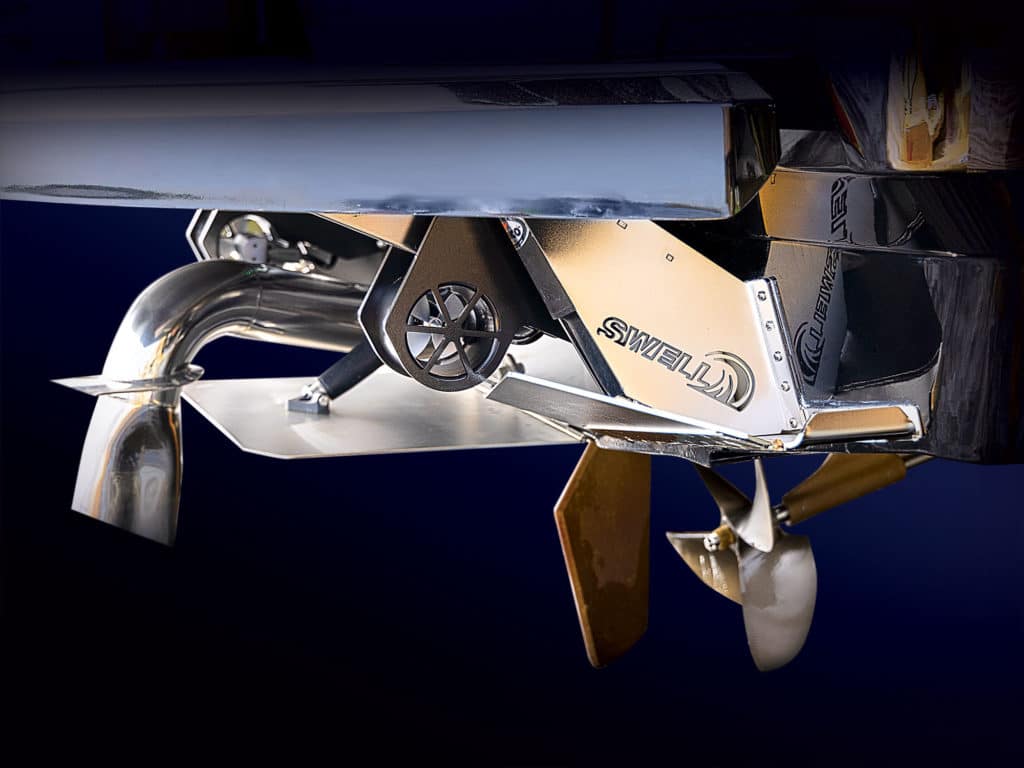
One driver who understands the value of integrated systems working together with the hull design is Trevor Hansen, a longtime professional wakeboarder and driver for the Supra Boats Pro Wakeboard Tour for the last six seasons.
“Having all the onboard systems work together isn’t just great for the riders in terms of dialing in a wake or wave they like, but it’s super-convenient for the drivers too,” Hansen says. “Making adjustments is easy, oftentimes just a tap on a screen or a push of a button on the steering wheel, and settings can be saved so you don’t have to worry about remembering specifics during a future ride.”
Plus, having a system such as AutoWake monitoring and adjusting settings on the fly proves convenient for both the rider and driver. “When I’m driving the best riders in the world on the PWT, it makes my job a lot easier, and it allows them to worry about landing their tricks instead of wondering how the boat is performing,” Hansen explains.
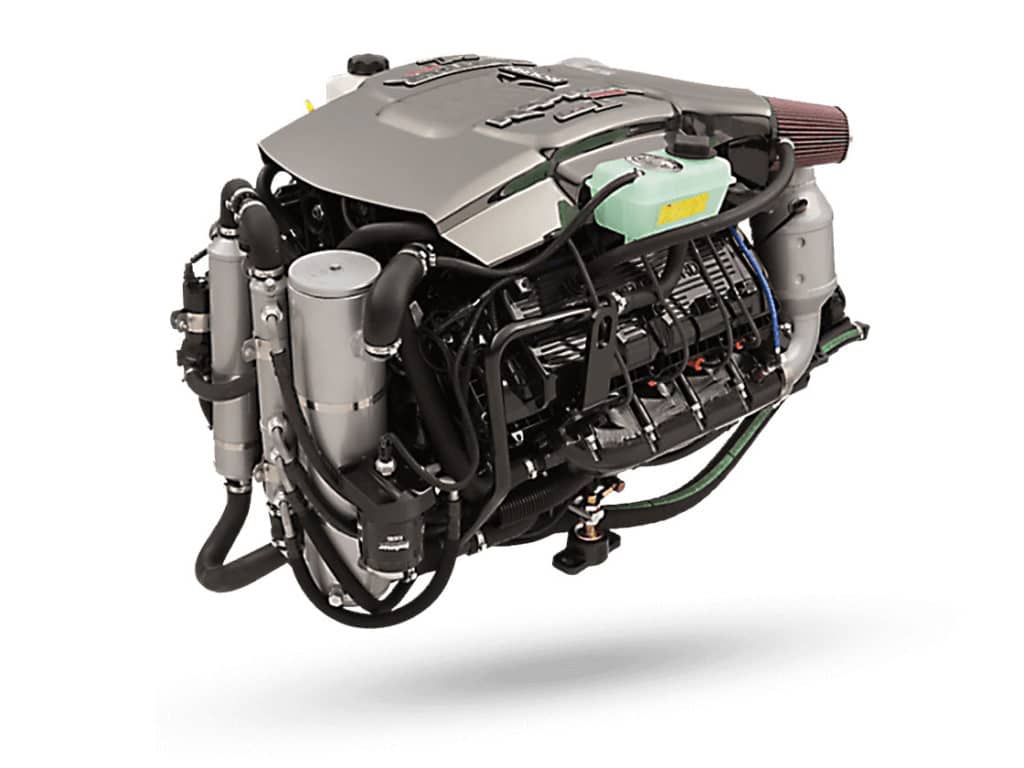
Propulsion
Propulsion of a boat can also have a major influence on the shape, consistency and rideability of a wakesurf wave. An advantage for an inboard tow boat is twofold. First, the propulsion is consistent; the thrust from the propeller always goes astern, while a rudder allows the boat to turn. With a forward-drive boat, the outdrive itself turns, meaning the direction of the thrust moves as the captain turns the wheel. The same applies to a jet-drive boat. While this might not affect the wave’s size too much, it plays a huge part in shaping and customizing the wave.
An inboard’s design and setup allow for mounting a central plate at the transom, as mentioned earlier with the Supra SmartPlate. Nearly every inboard wakesurf-boat manufacturer utilizes a center plate, the lone exception being Malibu with its proprietary Power Wedge design. The center-mounted plate adjusts to tweak the prop wash coming from the propeller. With the outdrive mounted at the transom of a forward-drive wakesurf boat, there is no area to mount a central plate.
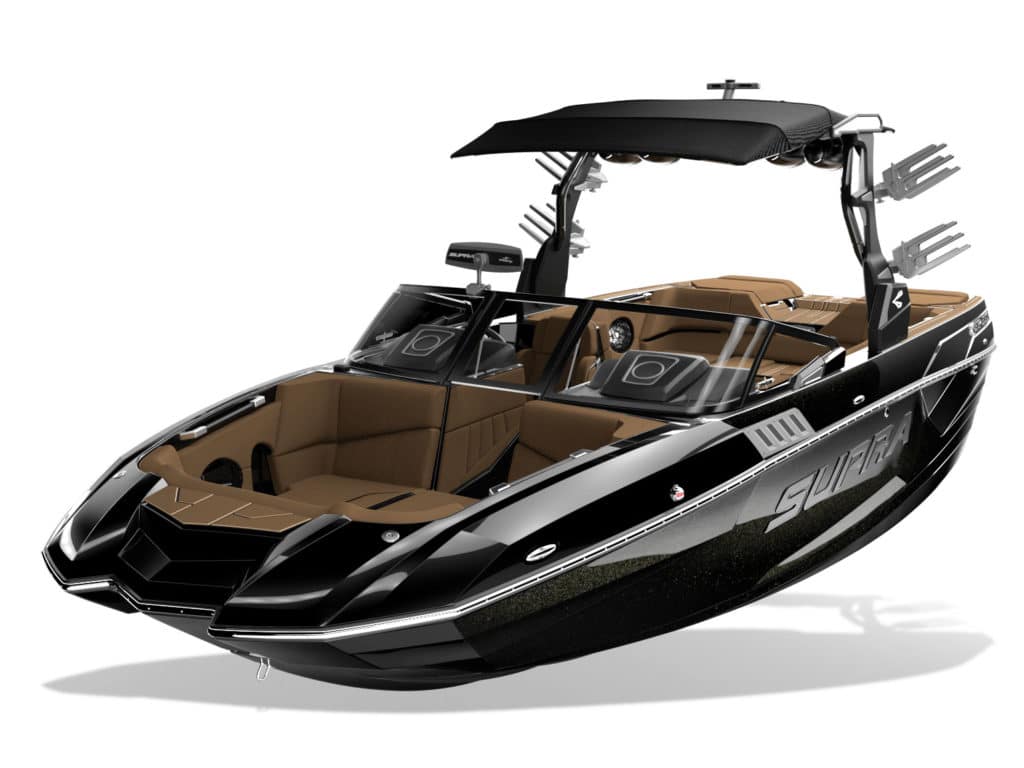
Time and Experience
When it comes to research and development for hull shapes and performance, nothing beats time and experience. Inboard tow-boat manufacturers have a head start when it comes to optimizing boats for wakeboarding and wakesurfing because they have been building high-performance watersports boats for years. While many of those boats were for water-skiers looking for smaller wakes, it worked out well when builders started lengthening the running surface, expanding the beam, and adding more freeboard and overall weight. Wakes, and then waves, got bigger and better. Inboard tow-boat manufacturers have been integrating onboard systems for riders to personally adjust wakes and waves for over 20 years.
Read Next: How to Get Up on a Wakesurf Board
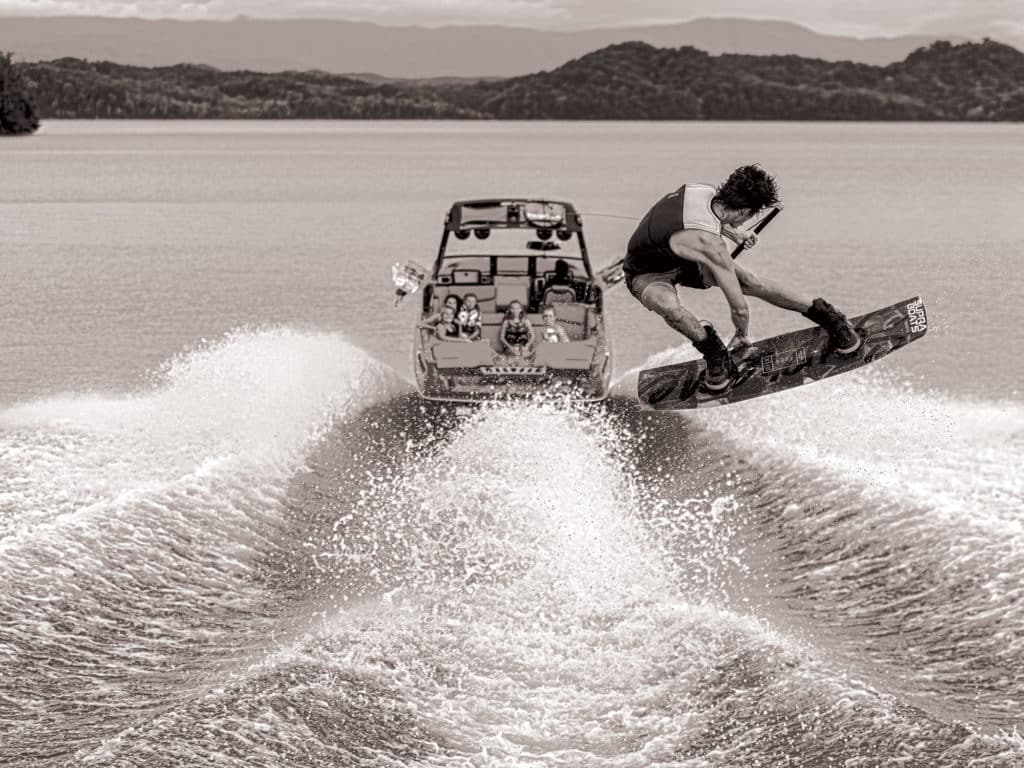
There is something to be said about getting a head start. Combine those years of experience and understanding with the mission of designing boats to optimize the wakeboarding and wakesurfing experience, and it’s easy to see why inboard tow-boat builders continue to dominate when it comes to ultimate wake and wave performance.
Of course, none of this is a slight to non-inboard watersports boats. There are many out there that perform at high levels—and with the help of time, they too have grown better. It comes back to the point made at the beginning of the article: There are more high-quality, capable boats to choose from than ever before. That is a good problem to have. The question becomes, are you a boater who has a serious focus on watersports and wants the best performing systems? Or are you a boater who needs a bit more versatility without as much focus on surfing waves? Only you can answer this.









